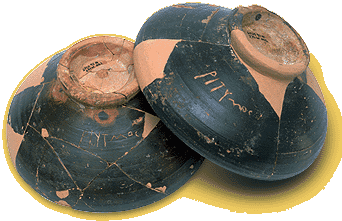- Home
- Gauls and Greeks
- Contacts with Greco-Roman cultures
- The Gauls of Provence and the Mediterranean world
Two small bowls from the 2nd century BC inscribed with the Roman name Ritumos
While history tells us mostly of the difficult political relations between the Greeks and the indigenous populations around Marseilles, their economic and cultural alliances were in fact more rich and complex. The economic ties established through exchange as early as the 6th century were the primary factor in the social structuration of Ligurian populations and new Celtic arrivals from the Alpes.
In the lower Rhone Valley, and near the coast, commercial activity with the Mediterranean developed significantly during the 5th century, but then declined at the beginning of the 4th, thus favoring interregional transactions (between southern indigenous populations and Marseilles). We cannot speak of a Hellenistic phenomenon before the end of the earliest Iron Age since the influences on architecture and writing are almost nonexistent. Exceptions are rare or depend on particular circumstances, such as at Arles where the port and the Greek colony established at the end of the 6th century (Theline) were transformed at the beginning of the 4th into an agglomeration with a mixed population (Arelate). Henceforth, this would become a cultural melting pot for the indigenous regional component, leading to the future integration of values of strong Mediterranean influence.
During the second half of the second Iron Age, in particular at the end of the 3rd century, the development of Celto-Ligurian societies, and renewed contacts with Greco-Italian cultures, had perceptible effects on part of the ruling aristocratic class. After the mid 2nd century these effects began to be apparent in the center of the lower Rhone Valley (as well as in Provence near the Alpilles and in the southern Vaucluse) in the domains of settlement, architecture and economy. They became especially evident within the basic cultural foundations of social, domestic and religious values.
Within these indigenous societies, which were undergoing a social mutation at the end of the 2nd century, the Poleis Massalias of Artemidore (indigenous agglomerations federated at, but not dependent upon, Marseilles) became significant, also though their sources of inspiration were much more Italic than Marseillan. Strabon later emphasized this evolution of part of the indigenous elite, which was henceforth adapted to the Greco-Italic culture (trilingual, contracts written in Greek; Géographie, IV, 1, 5). This social dynamic spread to other social levels within populations close to the most active economic centers, as can be seen in the limited practice of writing (with a Greek alphabet), the increased use of monies, and the parallel evolution of domestic and table customs.

